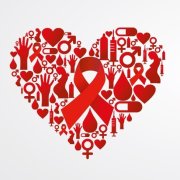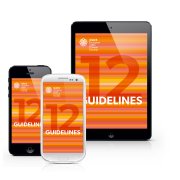From version 7.1 to 8.0
Version 8.0 includes major revisions to almost all sections of the EACS Guidelines. Most notably, the antiretroviral treatment (ART) recommendation of when to start ART has changed based on the results of the START study, and the co-infections section has been updated to reflect the major advances in anti-HCV treatment with direct acting antivirals (DAAs) and the phasing out of interferon-containing treatment. The section below describes in more detail the most important changes to each section of the 2015 edition of the Guidelines.
HIV TREATMENT SECTION
When to start: ART is now recommended for all HIV-positive persons, irrespectively of CD4 cell count. The main reasons for this change are the results of the START trial showing more favourable clinical outcomes among HIV-positive persons initiating ART at high CD4 cell counts as compared to persons initiating ART at lower CD4 cell counts. Along with this change, the recommendation of what to start has also changed.
What to start: Preferred regimens have been reduced from 13 to 6 options, 4 integrase inhibitors INSTI-based (DTG both with TDF/FTC or ABC/3TC, TDF/FTC/EVG/c and TDF/FTC + RAL), 1 non-nucleoside reverse transcriptase inhibitors - NNRTI-based (RPV/TDF/FTC), and one protease inhibitors - PI/r-based (DRV/r+ TDF/FTC). Changes are mainly based on the results of trials with regimens containing INSTIs. The panel also considered that at least one regimen containing a PI/r and one containing a NNRTI should be listed as ‘preferred’.
Post-exposure prophylaxis (PEP): Based on the results of the PARTNER study, the recommendations on PEP were revised to reflect that if an HIV-positive source person has documented undetectable plasma HIV-RNA, PEP is no longer recommended. The use of TDF/FTC + RAL or DRV/r is now also recommended as ARV regimens for PEP.
Pre-exposure prophylaxis (PrEP): A new section on PrEP has been added to the Guidelines. PrEP (TDF/FTC) should be recommended to high-risk MSM and transgender individuals and considered for high-risk heterosexual men and women. Both continuous and ‘on demand’ options are discussed as possible approaches.
CO-MORBIDITIES SECTION
Ageing and co-morbidities: A highlight was added on the advancing age of the general HIV-positive population, which may result in multiple simultaneous co-morbidities which again may require a comprehensive multidisciplinary assessment. As such, a more aggressive monitoring of renal function was recommended in individuals with an estimated glomerular filtration rate (eGFR) < 90 ml/min and with progressively declining eGFR. The use of chronic kidney disease risk equations is also recommended. Furthermore, screening for depression is now encouraged more widely due to the high prevalence, recommendations for smoking cessation were further elaborated and recommendations for regular assessment of liver disease in individuals with viral hepatitis co-infection with ultrasound and fibrosis staging were added.
New drugs/drug combinations: A number of new antiretroviral drugs/drug combinations were included in the revised drug-drug interaction tables, adverse effect tables, dose adjustment for renal/liver insufficiency tables and for administration recommendation of ART in individuals with swallowing difficulties. Several of these tables have, in previous versions of the EACS Guidelines, been available exclusively in the electronic version. However, due to requests from Guidelines users, the tables on dose adjustment for renal/liver insufficiency and administration of ART in individuals with swallowing difficulties are now also available in the printed version.
Drug-drug interactions: Two additional drug-drug interaction tables on possible interactions on corticosteroids and contraceptive drugs with the use of ART have been included in this new version.
Cardiovascular diseases (CVD) risk factors: In the general population, several guidelines on risk factors (i.e. dyslipidemia) for CVD have ceased to use threshold values. However, the co-morbidities panel has kept threshold values for all CVD risk factors to help everyday clinical practice.
Vaccination: A general recommendation to avoid polysaccharide vaccination was added, as was a recommendation of influenza and streptococcus pneumonia vaccination in all HIV-positive persons.
CO-INFECTIONS SECTION
Treatment of HBV: The text and table now reflect the general recommendation to start ART in the presence of HBV co-infection regardless of CD4 cell count.
Treatment of HCV: A stronger emphasis is put on interferon-free treatment regimen as well as earlier start of direct-acting antivirals - DAA treatment (well before F3 fibrosis). Although all detailed recommendations on interferon-containing regimens have been removed from the main section of the Guidelines, they are still available in a separate online addendum as several countries still use interferon-containing regimens. The text and tables have been updated following the licensing of SOF/LDV and AbbVie 3D Combo. The drug-drug interaction table on DAAs and ARVs has subsequently also been updated.
Acute HCV: The wording regarding management of acute HCV has been updated in the light of ongoing studies assessing interferon-free DAA regimen in acute HCV.
OPPORTUNISTIC INFECTIONS SECTION
While the content has not dramatically changed, its structure has undergone considerable modifications.
New tables: Entirely new tables were added on PML, Histoplasmosis, Cryptosporidiosis and Cycloisosporiasis and a section on Preemptive therapy for Cryptoccocsis. In addition, diagnostic criteria are provided for each pathogen/disease.


20th European AIDS Conference
15-18 October 2025 Paris, France

EACS Guidelines updated
The EACS 12.1 and the app are available for free on


Educational Programme
Training and educating the next generation of clinicians and researchers is an EACS core activity.

EACS Resource Library
Access all scientific content of EACS core activities! (members only)

Interim Guidance
Interim Guidance on the Use of Statin Therapy for the Primary Prevention of Cardiovascular Disease in People with HIV